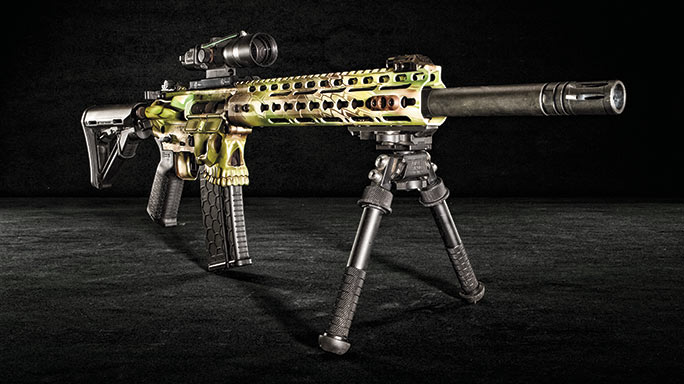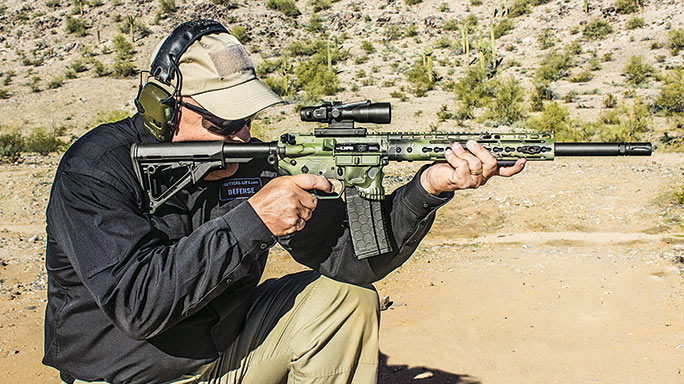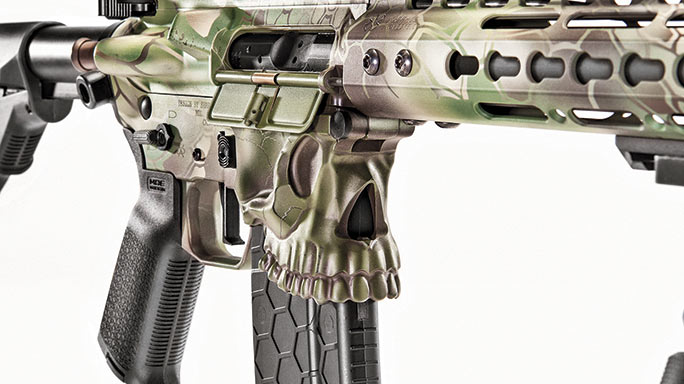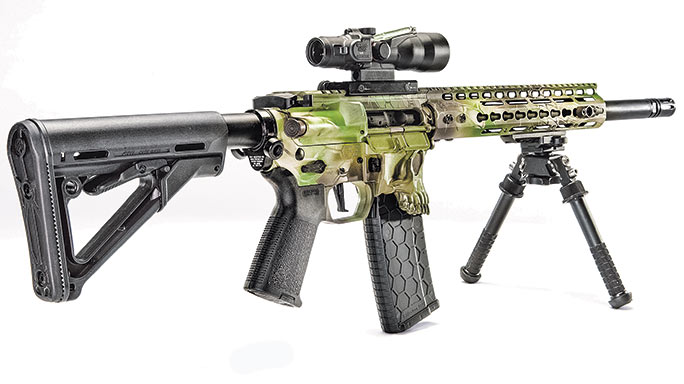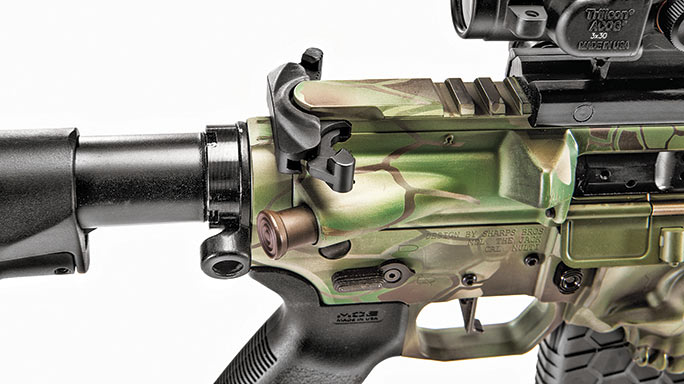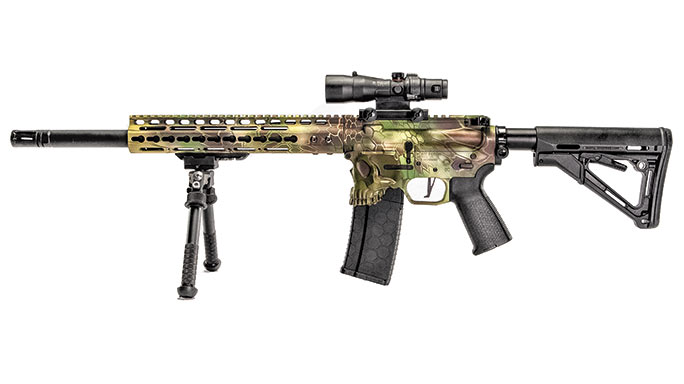The AR platform has become dramatically more than its original form, designed for 7.62mm and then the 5.56mm NATO rounds. Some might even wonder if Eugene Stoner had any idea of what he had begun when he launched his design. What was once the Armalite AR-10 has now become the seed for an entire new generation of guns. This versatile platform has become the launching point for a wide variety of chamberings — some as purely experimental forays, and some as a response to a need. Enter Sharps Bros. and the company’s custom .458 SOCOM AR build, which was a special project designed around Sharps’ popular and easily recognizable “The Jack” lower.
- RELATED STORY: Sneak Peek: Sharps Bros’ AR Build Project (in .458 SOCOM)
With its distinctive skull emerging from the front of the magazine well, it is a unique piece in and of itself. But there’s much more to this complete rifle and the meaty .458 SOCOM cartridge it was designed to launch.
.458 SOCOM Origins
Advertisement — Continue Reading Below
The .458 SOCOM round is a unique creature, but like most ammunition, it’s the product of the desire for a more effective combat round. During Operation Gothic Serpent in Mogadishu, Somalia, in 1993, the U.S. special operations community became frustrated with the 5.56mm NATO’s lack of stopping power. In what would later be called “Black Hawk Down,” U.S. Army Rangers and Delta Force operators were certain of their accuracy against local militants, yet the enemy combatants continued fighting. But their accuracy was not in question—5.56mm rounds seemed to simply pass through their targets without causing significant debilitating damage. So, U.S. soldiers had to put several rounds on target before they were effective.
This later led to operators looking for a new cartridge that would deliver far more energy from short barrels at relatively short distances. After several brainstorming sessions between designers and special operations community members, the .458 SOCOM started to take shape. Taking the lead on the new round was Marty ter Weeme, who founded Teppo Jutsu in early 2000. After much debate and discussion, it was suggested that the cartridge case design be a lengthened .50 AE case. This case would work well in magazines and would also be 100-percent compatible with the current M4 platform—not only in terms of fit, but also with other aspects of the gun, including the buffer, buffer spring and magazine well.
After the initial design was completed, Tony Rumore of Tromix was contacted to build the first .458 SOCOM prototype. Based on the favorable reviews, Tromix began producing commercial ARs chambered for this powerhouse cartridge in short order. Loads for the .458 SOCOM run the gamut from 250- to 600-grain projectiles, with an average 350-grain bullet producing over 2,496 foot-pounds of energy (fpe). This is over 1,100 fpe more than a standard 5.56mm NATO round. Coming in at more than twice the diameter of the 5.56mm round, the .458 SOCOM has the potential to create massive wound channels.
Advertisement — Continue Reading Below
Only a few companies manufacture upper receivers for this beefy round, including Tromix, Rock River Arms and Wilson Combat. As the .458 SOCOM’s popularity grows, however, more manufacturers are certain to join them. But the biggest challenge devotees to this round face is ammunition—it is hard to find and can be expensive. At a recent SWAT training event, I heard personnel talking about the .458 SOCOM, and the admiration of the round was obvious. It was described as a solid anti-personnel round as well as an anti-Brontosaurus round. While a bit of an exaggeration, the .458 SOCOM is serious business.
Custom Build
The .458 SOCOM AR that arrived from Sharps Bros. is a well-made specialty tool worthy of a detailed look. As mentioned, the unique nature of the .458 SOCOM round limits the number of companies that produce uppers for this beast. The upper Sharps chose for this model came from the serious folks at Rock River Arms (RRA). This forged A4-style receiver features a 16-inch, chrome-moly, bull barrel with a 1-in-14-inch twist rate. The barrel is topped off with a reliable A2-style flash suppressor.
Advertisement — Continue Reading Below
For the handguard, Sharps chose the 11-inch Noveske NSR. This is a hardcoat anodized aluminum handguard utilizing the KeyMod system for attaching accessories. The NSR has a continuous Picatinny top rail and fits the gun very well. Its smooth, slim design provides a good grip. Another modification to the upper was the inclusion of a Troy low-profile gas block. This was required to allow for the slim Noveske handguard. Finally, the well-thought-out upper was finished off with a BCM Gunfighter charging handle.
- RELATED STORY: Looking Sharp: Sharps Bros’ AR Lower Receivers
The lower is one of Sharps’ iconic designs. The Jack—with a skull emerging from the front of the magazine well—is recognizable anywhere. Like the upper receiver, it is machined from 7075-T6 aluminum that is then hardcoat anodized to military specifications for corrosion resistance. The lower includes an oversized triggerguard as well as a flared magazine well for enhanced reloading speed.
The lower is designed to support all mil-spec parts, thus allowing the end-user to easily trade out specific components. The internals for this specific gun came from Palmetto State Armory. The trigger chosen for this build was an ever-reliable CMC unit that breaks at a crisp 3.5 pounds. Rounding out the lower are Magpul’s CTR buttstock and MOE pistol grip.
Advertisement — Continue Reading Below
Now for the final touches. While a rifle with a skull emerging from the mag well is distinctive, this particular gun got some extra attention. It was sent to Blowndeadline, where it was given a great-looking, custom camo Cerakote finish. To say that this gun is unique is a major understatement.
Reaping Rewards
The gun world is littered with guns that are unique but spend most of their lives in safes. That was not the intent for this gun, and serious range time was encouraged. Because I had no plans to test the rifle at super long distances, I mount a Trijicon 3x30mm ACOG sight for the testing.
Advertisement — Continue Reading Below
While the .458 SOCOM round is not known for pinpoint accuracy, I felt that this rifle would create some respectable results, and I was not disappointed. For this session, I used three sets of ammunition: 300-grainers from Southern Ballistic Research (SBR), 500-grain subsonics from Detroit Ammo and 300-grain handloads. Of course, if you’re looking for .458 SOCOM ammunition, your best bet is to look online. It’s certainly not a standard commodity at your local big box sporting goods store. Coming in at over $3 a round, handloading is a popular pastime for serious shooters of this big round. Thus, having scrounged enough ammo, I began testing the gun at 50 yards.
A couple of interesting things are worth mentioning. As with so many large-bore guns, there is a belief that the recoil is harsh and unmanageable. But that is not even close to the case with the Sharps Bros. rifle. It is a smooth-shooting machine that harnesses the massive power of this round. My five-round groups were solid and proved that the .458 SOCOM is more accurate than many believe. The best group for the day came in at 0.75 inches, and the biggest group was only a hair over an inch.
A fast-moving rainstorm ruined the chance of measuring groups at 100 yards. Prior to that, however, I was able to thoroughly vet the rifle. The rifle has some truly quality components, and it ran very well. One thing that is difficult to express or even measure in a gun like this is the power. I ran a side-by-side comparison between the .458 SOCOM and a 5.56mm AR, firing at a 6-by-18-inch popper set at 50 yards. The 5.56mm struck cleanly and easily moved the popper back, but the .458 hit the popper so hard that it blew it out of its base. A 300-grain bullet definitely has stopping power.
Advertisement — Continue Reading Below
The rifle proved to be a perfect balance of weight and firepower. It is easy to fire multiple shot strings at steel without losing control. The AR simply held its ground as rounds flew downrange to ring the steel.
RRA suggests using standard GI magazines with the .458 SOCOM because of the pressure on the magazines’ feed lips. For the test I used metal mags as well as a well-made Lancer AWM magazine with feed lips that had been carefully modified by Wilson Combat to hold the .458 SOCOM higher in the tube, allowing for a wider variety of projectile shapes. Wilson also cut a deeper clearance at the front of the magazine body to allow the big .458 SOCOM case to clear the magazine better during the feeding cycle. The result is a smooth-feeding magazine.
Big-Bore Enforcer
Advertisement — Continue Reading Below
Overall, this rifle’s performance was solid. My thoughts quickly ran to applications for this work of art, and hunting came to mind. While the .458 SOCOM round was initially designed to fill the spec-ops community’s need to put down bad guys, it also has the ability to drop game like wild hogs. A 500-grain bullet expanding on impact has a way of stopping just about any animal.
- RELATED STORY: Meanstreak: Sharps Bros’ AR-15 Lower Receiver
While some may have seen the unique lowers coming out of the Sharps Bros. shop as a fleeting fad, they are wrong. The designs are unique on the outside, and the lowers themselves are well made and capable of being the foundation for a variety of solid rifles. Besides, a little flair never hurt anyone, and this .458 SOCOM rifle is a prime example of that. Under the flash lies the soul of a serious rifle—one worthy of serious consideration.
For more information, visit SharpsBros.com.
Advertisement — Continue Reading Below
Specifications
- Caliber: .458 SOCOM
- Barrel: 16 inches
- OA Length: 32-36 inches
- Weight: 7 pounds (empty)
- Stock: Magpul CTR
- Sights: None
- Action: Direct impingement semi-auto
- Finish: Camo Cerakote
- Capacity: 11+1
- MSRP: N/A
